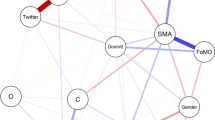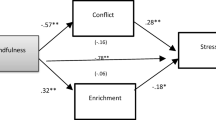Abstract
The present study examined whether relationships of self-reported depression and suicidality to gender roles or gender are moderated by the type of stressful life events that individuals experience. The focus was on events in stereotypic male (achievement) versus female (interpersonal) domains. This study of 290 women and 247 men undergraduates employed the Beck Depression Inventory (BDI), the Personal Attributes Questionnaire and a measure of recent negative life events. In the presence of high achievement stress, high masculinity was related to low suicidality for men. In the presence of high interpersonal stress, high femininity was related to low self-reported depression for women. These findings were interpreted as consistent with the androgyny model of adjustment. However, independent of gender roles, high interpersonal stress was related to high self-reported depression more strongly among women than among men. Suicidality was related to interpersonal events for women and achievement events for men. These findings were interpreted as consistent with the self-schema model of depression.
Similar content being viewed by others
References
Adams, C. A., & Sherer, M. (1985). Sex role orientation and psychological adjustment: Implications for the masculinity model.Sex Roles, 12 1121–1128.
Beck, A. T., Lester, D., & Kovacs, M. (1973). Attempted suicide by males and females.Psychological Reports, 33 965–966.
Beck, A. T., Ward, C. H., Mendelson, M., Mock, J., & Erbaugh, J. (1961). An inventory for measuring depression.Archives of General Psychiatry, 4 561–571.
Bem, S. L. (1974). The measurement of psychological androgyny.Sex Roles, 47 155–162.
Bem, S. L. (1975). Sex-role adaptability: One consequence of psychological androgyny.Journal of Personality and Social Psychology, 31 634–643.
Blais, M. R., Vallerand, R. J., Briere, N. M., Gagnon, A., & Pelletier, L. G. (1990). Significance, structure, and gender differences in life domains of college students.Sex Roles, 22 199–212.
Billings, A. G., Cronkite, R. C., & Moos, R. H. (1983). Social-environmental factors in unipolar depression: Comparisons of depressed patients and nondepressed controls.Journal of Abnormal Psychology, 92 119–133.
Boggiano, A. K., & Barrett, M. (1991). Gender differences in depression in college students.Sex Roles, 25 595–605.
Breed, W. (1967). Suicide and loss in social interaction. In E. S. Shneidman (Ed.),Essays in self-destruction. New York: Science.
Curran, D. K. (1987).Adolescent suicidal behavior. Washington: Hemisphere.
Elpern, S., & Karp, S. A. (1984). Sex-role orientation and depressive symptomatology.Sex Roles, 10 987–992.
Feather, N. T. (1985). Masculinity, femininity, self-esteem, and subclinical depression.Sex Roles, 12 491–500.
Formanek, R., & Gurian, A. (Eds.). (1987).Women and depression: A lifespan perspective. New York: Springer.
Frisch, M. B., & McCord, M. (1987). Sex role orientation and social skill: A naturalistic assessment of assertion and conversational skill.Sex Roles, 17 437–448.
Hammen, C., Ellicott, A., Gitlin, M., & Jamison, K. R. (1989). Sociotropy/autonomy and vulnerability to specific life events in patients with unipolar depression and bipolar disorders.Journal of Abnormal Psychology, 98 154–160.
Hammen, C., Marks, T., Mayol, A., & deMayo, R. (1985). Depressive self-schemas, life stress, and vulnerability to depression.Journal of Abnormal Psychology, 94 308–319.
Hammen, C., Mayol, A., deMayo, R., & Marks, T. (1986). Initial symptom levels and the life-event-depression relationship.Journal of Abnormal Psychology, 95 114–122.
Hammen, C., Miklowitz, D. J., & Dyck, D. G. (1986). Stability and severity parameters of depressive self-schema responding.Journal of Social and Clinical Psychology, 4, 23–45.
Hammersla, J. F., & Frease-McMahan, L. (1990). University students' priorities: Life goals vs. relationships.Sex Roles, 23 1–14.
Hodges, W. F. (1978).Recent Life Events-College Scale. Unpublished manuscript, University of Colorado, Boulder.
Holmes, T. H., & Rahe, R. H. (1967). The social readjustment rating scale.Journal of Psychosomatic Research, 11 213–218.
Jack, D. (1987). Self-in-relation theory. In R. Formanek & A. Gurian (Eds.),Women and depression: A lifespan perspective. New York: Springer.
Josephson, J. S. (1988).Feminine orientation as a mediator of moral judgment. Unpublished doctoral dissertation, University of Colorado, Boulder, Colorado.
Katz, P. A., Boggiano, A. K., & Silvern, L. E. (1993). Theories of female personality. In F. Denmark & M. Paludi (Eds.),Handbook of the psychology of women. Easport, CT: Greenwood Press.
Kovacs, M., Beck, A. T., & Weissman, A. (1975). Hopelessness: An indicator of suicidal risk.Suicide and Life-Threatening Behavior, 5 98–103.
Leaper, C. (1987). Agency, communion, and gender as predictors of communication style and being liked in adult male-female dyads.Sex Roles, 16 137–149.
Lester, D. (1984). Suicide. In C. S. Widom (Ed.),Sex roles and psychopathology. New York: Plenum.
Linehan, M. M. (1973). Suicide and attempted suicide: Study of perceived sex differences.Perceptual and Motor Skills, 37 31–34.
Marcus, B. F. (1987). Object relations theory. In R. Formanek & A. Gurian (Eds.),Women and depression: A lifespan perspective. New York: Springer.
Maris, R. (1981).Pathways to suicide: A survey of self-destructive behaviors. Baltimore, MD: The John Hopkins University Press.
Nezu, A. M., & Nezu, C. M. (1987). Psychological distress, problem-solving, and coping reactions: Sex role differences.Sex Roles, 16 205–214.
Nolan-Hoeksema, S. (1990).Sex differences in depression. Stanford, CA: Stanford University.
Oliver, S. J., & Toner, B. B. (1990). The influence of gender role typing on the expression of depressive symptoms.Sex Roles, 22 775–790.
Padesky, C. A., & Hammen, C. L. (1981). Sex differences in depressive symptom expression and help-seeking among college students.Sex Roles, 7 309–320.
Payne, F. D. (1987). “Masculinity,” “femininity” and the complex construct of adjustment.Sex Roles, 17 359–374.
Radloff, L., & Rae, D. (1979). Susceptibility and precipitating factors in depression: Sex differences and similarities.Journal of Abnormal Psychology, 88 174–181.
Robins, C. J., & Block, P. (1988). Personal vulnerability, life events, and depressive symptoms: A test of a specific interaction model.Journal of Personality and Social Psychology, 54 847–852.
Roos, P. E., & Cohen, L. H. (1987). Sex roles and social support as moderators of life stress adjustment.Journal of Personality and Social Psychology, 52 576–585.
Rudd, M. D. (1989). The prevalence of suicidal ideation among college students.Suicide and Life-Threatening Behavior, 19 173–183.
Silvern L. E., & Ryan, V. L. (1979). Self-rated adjustment and sex-typing on the Bem Sex Role Inventory: Is masculinity the primary predictor of adjustment?Sex Roles, 5 739–763.
Silvern, L. E., & Ryan, V. L. (1983). A reexamination of masculine and feminine sex-role ideals and conflicts among ideals for the man, woman, and person.Sex Roles, 9 1223–1248.
Spence, J. T. (1984). Masculinity, femininity, and gender-related traits: A conceptual analysis and critique of current research. In B. A. Maher & W. B. Maher (Eds.),Progress in experimental personality research: (Vol. 13),Normal personality processes. Orlando, FL: Academic Press.
Spence, J. T., & Helmreich, R. L. (1978).Masculinity and femininity: Their psychological dimensions, correlates, and antecedents. Austin: University of Texas.
Steenbarger, B. N., & Greenberg, R. P. (1990). Sex roles, stress, and distress: A study of person by situation contingency.Sex Roles, 22 59–68.
Stoppard, J. M., & Paisley, K. J. (1987). Masculinity, femininity, life stress, and depression.Sex Roles, 16 489–496.
Taylor, M. C., & Hall, J. A. (1982). Psychological androgyny: Theories, methods. and conclusions.Psychological Bulletin, 92 347–366.
Weissman, M. M., & Klerman, G. L. (1987). Gender and depression. In R. Formanek & A. Gurian (Eds.),Women and depression: A lifespan perspective. New York: Springer.
Weissman, M. M., Leaf, P. J., Holzer, C. E., Myers, J. K., & Tischler, G. L. (1984). The epidemiology of depression: An update on sex differences in rates.Journal of Affective Disorders, 7 179–188.
Whitley, B. E. (1983). Sex-role orientation and self-esteem: A critical meta-analytic review.Journal of Personality and Social Psychology, 44 773–786.
Whitley, B. E. (1985). Sex-role orientation and psychological well-being: Two meta-analyses.Sex Roles, 12 207–225.
Zeldow, P. B., Clark, D. C., Daugherty, S. R., & Eckenfels, E. J. (1985). Personality indicators of psychosocial adjustment in first-year medical students.Social Science and Medicine, 20 95–100.
Zuckerman, D. M. (1989). Stress, self-esteem, and mental health: How does gender make a difference?Sex Roles, 20 429–443.
Author information
Authors and Affiliations
Additional information
The authors gratefully acknowledge Jane Karyl and Ann Shields for substantial assistance with data collection and management and Michael L. DeKay for assistance with data analysis. The following individuals assisted with data collection and other phases of the study: Joanne Starek, Robert Wilking, Haur Khar Khaba, Rochelle Dalla, Kristin Iverson, and Michele LeClaire.
Rights and permissions
About this article
Cite this article
Waelde, L.C., Silvern, L. & Hodges, W.F. Stressful life events: Moderators of the relationships of gender and gender roles to self-reported depression and suicidality among college students. Sex Roles 30, 1–22 (1994). https://doi.org/10.1007/BF01420737
Issue Date:
DOI: https://doi.org/10.1007/BF01420737




